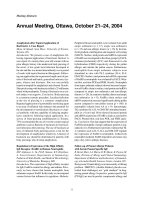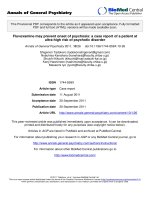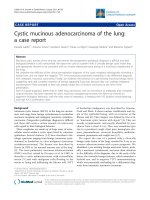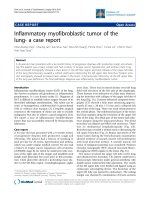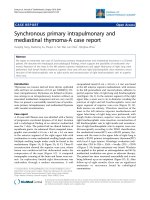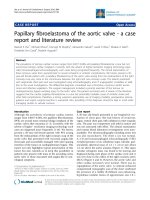Báo cáo y học: " Cecum perforation due to tuberculosis in a renal transplant recipient: a case report" pdf
Bạn đang xem bản rút gọn của tài liệu. Xem và tải ngay bản đầy đủ của tài liệu tại đây (1.01 MB, 3 trang )
BioMed Central
Page 1 of 3
(page number not for citation purposes)
Journal of Medical Case Reports
Open Access
Case report
Cecum perforation due to tuberculosis in a renal transplant
recipient: a case report
Sinan Carkman, Volkan Ozben and Erman Aytac*
Address: Department of General Surgery, Istanbul University, Cerrahpasa Medical Faculty, Istanbul, Turkey
Email: Sinan Carkman - ; Volkan Ozben - ; Erman Aytac* -
* Corresponding author
Abstract
Introduction: Tuberculosis can present in many varied clinical situations in immunosuppressed
patients. It has been reported that the sigmoid colon is the most common site for colonic
perforation in renal transplant recipients and diverticulitis is its most common cause. Cecal
perforation because of tuberculosis is extremely rare in a renal transplant recipient. We present
the case of a renal transplant patient with cecal perforation due to tuberculosis, 10 years after renal
transplantation.
Case presentation: A 39-year-old Caucasian man, who was a renal transplant recipient, was
admitted to our emergency surgery unit with an acute abdomen. A cecal perforation was found at
exploratory laparotomy, and a right hemicolectomy with an end ileostomy and transverse colonic
mucous fistula were performed. Necrotizing granulomatous colitis due to tuberculosis was
reported in the histopathologic examination.
Conclusion: Colonic perforations in immunosuppressed patients may have unusual presentations
and unusual causes. Tuberculosis infection should be considered in the differential diagnosis during
the histopathologic evaluation in immunocompromised patients such as renal transplant recipients.
Introduction
Patients with end-stage renal disease and renal transplant
recipients suffer from tuberculosis (TB) more than other
individuals because of their chronic immunosuppression.
In transplant patients, the rate of active TB is 0.48% in the
United States and 11.8% in India [1]. Diagnosis of TB is
difficult and early diagnosis is essential as delay in the
diagnosis and treatment results in progression of the dis-
ease with increased risk for renal damage and mortality
[2]. Lethal complications in solid organ transplants nota-
bly include colonic complications, and colonic perfora-
tion has been of particular concern due to the high risk of
mortality [3]. It has been reported that the sigmoid colon
is the most common site for colonic perforation in renal
transplant recipients and diverticulitis is the most com-
mon cause of perforation [4]. Cecum perforation due to
TB is extremely rare. We present the case of a renal trans-
plant patient with cecal perforation due to TB, 10 years
after renal transplantation.
Case presentation
A 39-year-old Caucasian man was admitted to our emer-
gency surgery unit with complaints of acute abdominal
pain, fever and chills. His past medical history revealed
that 10 years previously, he had undergone right renal
transplantation following 18 months of hemodialysis due
to end stage renal failure secondary to amyloidosis. He
had been treated with immunosuppressive therapy for
Published: 18 November 2009
Journal of Medical Case Reports 2009, 3:132 doi:10.1186/1752-1947-3-132
Received: 28 December 2008
Accepted: 18 November 2009
This article is available from: />© 2009 Carkman et al; licensee BioMed Central Ltd.
This is an Open Access article distributed under the terms of the Creative Commons Attribution License ( />),
which permits unrestricted use, distribution, and reproduction in any medium, provided the original work is properly cited.
Journal of Medical Case Reports 2009, 3:132 />Page 2 of 3
(page number not for citation purposes)
nearly 10 years (prednisolone 500 mg, tacrolimus 1 mg,
mycophenolate sodium 360 mg) after he developed
membranous glomerulonephritic chronic renal rejection.
He had been admitted to our chest medicine clinic 10
months before this admission with complaints of pleu-
ritic chest pain, fever and weight loss. Radiological (chest
X-ray, and chest computed tomography (CT)) and labora-
tory (blood culture, urinary antigen, tuberculin skin test-
ing) tests for TB were inconclusive and he was diagnosed
with pneumonia. His clinical condition gradually
improved with antibiotic therapy (ceftriaxone 2 g/day).
However, he sometimes suffered from night sweats and
weight loss. His family history revealed that his father had
been diagnosed with pulmonary tuberculosis 7 years ear-
lier for which the father had received rifampicin.
On physical examination, the patient appeared septic and
unwell. His vital signs were: blood pressure: 130/80
mmHg, heart rate: 96 beats/minute, axillary temperature:
38.3°C, respiratory rate: 28/minute, oxygen saturation:
96%. Palpation of the abdomen revealed diffuse rigidity
and rebound tenderness. Painful rectal ulcers were noted
on digital rectal examination. All of the serologic and lab-
oratory findings were normal except for white blood cell
count (WBC): 14,900 cells/mm
3
, hematocrit (Hct):
28.7%, blood urea nitrogen (BUN): 78 mg/dl, creatinine:
3.1 mg/dl, C-reactive protein: 168 U/dl. Subdiaphrag-
matic free air was detected on plain chest X-ray study. An
abdominal CT scan revealed pericecal inflammation and
bowel perforation without any evidence of distal bowel
obstruction (Figure 1).
An emergent exploratory laparotomy was performed and
during exploration, intra-abdominal minimal purulent
fluid, pseudomembranes, multiple lymphadenopathies
measuring up to 1 cm in the mesenteric root and cecal per-
foration were detected (Figure 2). A right hemicolectomy
with end ileostomy and transverse colonic mucous fistula
was performed. Necrotizing granulomatous colitis due to
TB was reported in the histopathologic examination (Fig-
ure 3). An antituberculosis drug regimen (pyrazinamide,
rifampicin, isoniazid, ethambutol) was added to the
patient's immunosuppressive treatment. The early post-
operative period was uneventful and the patient improved
rapidly. The rectal ulcers also regressed clinically. Ileos-
tomy and colostomy closure were scheduled to be per-
formed after full recovery.
Discussion
The varied presentation of TB after transplantation is a
challenge to the physician because immunosuppression
masks the clinical course of TB and is difficult to interpret.
Intestinal TB should be considered when a transplant
recipient shows abdominal symptoms with no clear evi-
dence of another infection [5-7]. Crohn's disease, amebi-
asis, carcinoma of the colon, Yersinia enterocolitis,
gastrointestinal histoplasmosis, and peri-appendiceal
abscesses closely simulate intestinal TB [8]. When TB is
diagnosed during routine clinical follow-up, conventional
antituberculosis agents are effective. However, when
emergent clinical complications such as obstruction, per-
foration or fistula formations occur, surgery will be
needed. Most patients with intestinal TB are diagnosed
post mortem or after exploratory laparotomy and bowel
resection. It has been reported that the sigmoid colon is
Intra-abdominal free air identified on abdominal computed tomography scanFigure 1
Intra-abdominal free air identified on abdominal
computed tomography scan.
Macroscopic view of the specimenFigure 2
Macroscopic view of the specimen. The cecal perfora-
tion is shown with an instrument (AC: ascending colon, C:
cecum, A: appendix, DI: distal ileum).
Journal of Medical Case Reports 2009, 3:132 />Page 3 of 3
(page number not for citation purposes)
the most common site for colonic perforation in renal
transplant recipients and that diverticulitis is the most
common cause of perforation [4]. Stelzner et al. reported
a colonic perforation rate of 2.1% and a mortality rate of
38% in 1401 renal transplant recipients [9]. Patients with
renal failure who are undergoing dialysis are at risk for
colonic perforation due to chronic constipation, electro-
lyte imbalance, dehydration, inactivity and corticosteroid
treatment, [4,10].
Our patient, who is a renal transplant recipient, presented
with an acute abdomen. During abdominal exploration, a
cecal perforation was diagnosed. A right hemicolectomy
with an end ileostomy and transverse colonic mucous fis-
tula was performed. We did not perform a primary intes-
tinal anastomosis because there was diffuse peritonitis,
and because, with the patient's immunosuppression, fail-
ure of the anastomosis was probable.
Conclusion
The symptoms of TB are variable depending on the loca-
tion of the disease and the immune condition of the
patient. In our patient, a renal transplant recipient, TB
caused cecal perforation. The location of the perforation
site and the reason for the perforation were unusual for
renal transplant recipients. An antituberculosis drug regi-
men was added to his treatment after the identification of
TB infection by histopathology. The patient has improved
rapidly with the antituberculosis therapy. TB infection
should be considered in the differential diagnosis during
the histopathologic evaluation of immunocompromised
patients such as renal transplant recipients.
Abbreviations
BUN: blood urea nitrogen; CRP: C-reactive protein; CT:
computed tomography: Hct: hematocrit; TB: tuberculosis;
WBC: white blood cell count.
Consent
Written informed consent was obtained from the patient
for publication of this case report and any accompanying
images. A copy of the written consent is available for
review by the Editor-in-Chief of this journal.
Competing interests
The authors declare that they have no competing interests.
Authors' contributions
SC and VO were the surgeons who performed the opera-
tion and close follow-up of the patient. VO and EA ana-
lyzed and interpreted the patient data regarding
transplant and VO was the major contributor in writing
the manuscript. All authors read and approved the final
manuscript.
References
1. Sakhuja V, Jha V, Varma PP, Joshi K, Chung KS: The high incidence
of tuberculosis among renal transplant recipients in India.
Transplantation 1996, 27:211-215.
2. Chen CH, Lian JD, Cheng CH, Wu MJ, Lee WC, Shu KH: Mycobac-
terium tuberculosis infection following renal transplantation
in Taiwan. Transpl Infect Dis 2006, 8:148-156.
3. Remzi FH: Colonic complications of organ transplantation.
Transplant Proc 2002, 34:2119-2121.
4. Church JM, Fazio VW, Braun WE, Novick AC, Steinmuller DR: Per-
foration of the colon in renal homograft recipients. A report
of 11 cases and a review of the literature. Ann Surg 1986,
203:69.
5. Mahara B, Bonten H, van Hooff H, Fiolet H, Buiting AG, Stoobberingh
EE: Infectious complications and antibiotic use in renal trans-
plant recipients during 1-year follow up. Clin Microbiol Infect
2001, 7:619-625.
6. Lam DTY, Tang HL, Tong KL: Tuberculosis in post renal trans-
plant patients. J Hong Kong Med Assoc 1992, 44:169-175.
7. Kandutsch S, Feix A, Haas M, Häfner M, Sunder-Plassmann G, Solei-
man A: A rare cause of anemia due to intestinal tuberculosis
in a renal transplant recipient. Clin Nephrol 2004, 62:158-161.
8. Khuroo MS, Khuroo NS: Abdominal tuberculosis. In Tuberculosis
Edited by: Madkour MM, Warrell DA. Berlin: Springer; 2004:659-667.
9. Stelzner M, Vlahakos DV, Milford EL, Tilney NL: Colonic perfora-
tions after renal transplantation. J Am Coll Surg 1997, 184:63.
10. Komorowski RA, Cohen EB, Kauffman HM, Adams MB: Gastroin-
testinal complications in renal transplant recipients. Am J Clin
Pathol 1986, 86:161.
Arrows indicate the tuberculosis bacilli in the colonic mucosa stained with Ziehl-Neelsen dyeFigure 3
Arrows indicate the tuberculosis bacilli in the colonic
mucosa stained with Ziehl-Neelsen dye.
